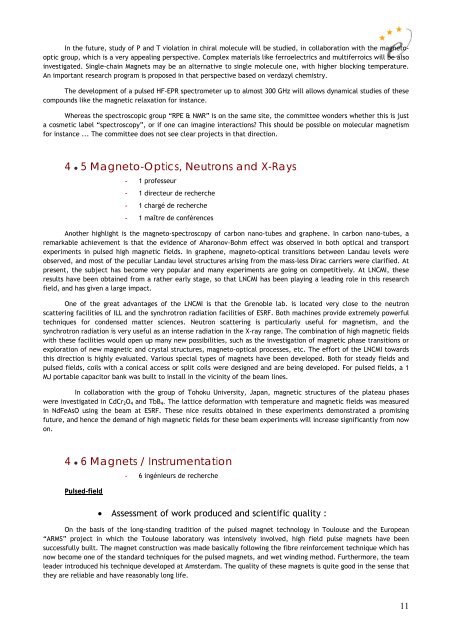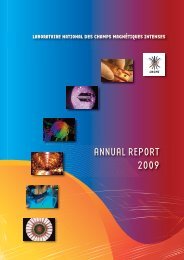Laboratoire National des Champs Magnétiques Pulsés CNRS – INSA
Laboratoire National des Champs Magnétiques Pulsés CNRS – INSA
Laboratoire National des Champs Magnétiques Pulsés CNRS – INSA
Create successful ePaper yourself
Turn your PDF publications into a flip-book with our unique Google optimized e-Paper software.
In the future, study of P and T violation in chiral molecule will be studied, in collaboration with the magnetooptic<br />
group, which is a very appealing perspective. Complex materials like ferroelectrics and multiferroics will be also<br />
investigated. Single-chain Magnets may be an alternative to single molecule one, with higher blocking temperature.<br />
An important research program is proposed in that perspective based on verdazyl chemistry.<br />
The development of a pulsed HF-EPR spectrometer up to almost 300 GHz will allows dynamical studies of these<br />
compounds like the magnetic relaxation for instance.<br />
Whereas the spectroscopic group “RPE & NMR” is on the same site, the committee wonders whether this is just<br />
a cosmetic label “spectroscopy”, or if one can imagine interactions? This should be possible on molecular magnetism<br />
for instance ... The committee does not see clear projects in that direction.<br />
4 � 5 Magneto-Optics, Neutrons and X-Rays<br />
- 1 professeur<br />
- 1 directeur de recherche<br />
- 1 chargé de recherche<br />
- 1 maître de conférences<br />
Another highlight is the magneto-spectroscopy of carbon nano-tubes and graphene. In carbon nano-tubes, a<br />
remarkable achievement is that the evidence of Aharonov-Bohm effect was observed in both optical and transport<br />
experiments in pulsed high magnetic fields. In graphene, magneto-optical transitions between Landau levels were<br />
observed, and most of the peculiar Landau level structures arising from the mass-less Dirac carriers were clarified. At<br />
present, the subject has become very popular and many experiments are going on competitively. At LNCMI, these<br />
results have been obtained from a rather early stage, so that LNCMI has been playing a leading role in this research<br />
field, and has given a large impact.<br />
One of the great advantages of the LNCMI is that the Grenoble lab. is located very close to the neutron<br />
scattering facilities of ILL and the synchrotron radiation facilities of ESRF. Both machines provide extremely powerful<br />
techniques for condensed matter sciences. Neutron scattering is particularly useful for magnetism, and the<br />
synchrotron radiation is very useful as an intense radiation in the X-ray range. The combination of high magnetic fields<br />
with these facilities would open up many new possibilities, such as the investigation of magnetic phase transitions or<br />
exploration of new magnetic and crystal structures, magneto-optical processes, etc. The effort of the LNCMI towards<br />
this direction is highly evaluated. Various special types of magnets have been developed. Both for steady fields and<br />
pulsed fields, coils with a conical access or split coils were <strong>des</strong>igned and are being developed. For pulsed fields, a 1<br />
MJ portable capacitor bank was built to install in the vicinity of the beam lines.<br />
In collaboration with the group of Tohoku University, Japan, magnetic structures of the plateau phases<br />
were investigated in CdCr 2O 4 and TbB 4. The lattice deformation with temperature and magnetic fields was measured<br />
in NdFeAsO using the beam at ESRF. These nice results obtained in these experiments demonstrated a promising<br />
future, and hence the demand of high magnetic fields for these beam experiments will increase significantly from now<br />
on.<br />
4 � 6 Magnets / Instrumentation<br />
Pulsed-field<br />
- 6 ingénieurs de recherche<br />
� Assessment of work produced and scientific quality :<br />
On the basis of the long-standing tradition of the pulsed magnet technology in Toulouse and the European<br />
“ARMS” project in which the Toulouse laboratory was intensively involved, high field pulse magnets have been<br />
successfully built. The magnet construction was made basically following the fibre reinforcement technique which has<br />
now become one of the standard techniques for the pulsed magnets, and wet winding method. Furthermore, the team<br />
leader introduced his technique developed at Amsterdam. The quality of these magnets is quite good in the sense that<br />
they are reliable and have reasonably long life.<br />
11







